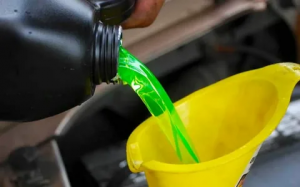Automotive Coolant Market Anticipated to Reach USD 10.39 Billion, at a Notable 3.49% CAGR by 2032
Automotive Coolant Market is projected to be valued at over USD 10.39 billion by 2032, at a CAGR of over 3.49% during the forecast period 2032.
NEW YORK, NY, UNITED STATES, August 6, 2025 /EINPresswire.com/ -- The automotive coolant market plays a critical role in the automotive industry, ensuring the proper thermal management of vehicle engines. Coolants, also known as antifreeze, are essential fluids used to regulate engine temperature and prevent overheating or freezing, depending on external conditions. The market has experienced significant growth over the years, driven by rising vehicle production, increasing awareness of preventive maintenance, and stricter environmental regulations.The automotive coolant market size was valued at USD 7.59 Billion in 2023 and is projected to reach USD 10.39 Billion by 2032, growing at a CAGR of 3.49% from 2024 to 2032.
Key Market Trends
Several key trends are shaping the evolution of the automotive coolant market:
Shift Toward Long-Life Coolants
With consumers increasingly seeking low-maintenance solutions, there is a strong trend toward long-life coolants that offer extended replacement intervals. These coolants reduce the frequency of servicing, thereby lowering ownership costs and improving convenience.
Rising Demand for Environmentally Friendly Products
Traditional coolants often contain substances that are harmful to the environment. As sustainability becomes a priority, manufacturers are investing in eco-friendly coolant formulations that are biodegradable, non-toxic, and free of harmful additives. These developments align with environmental standards and regulations.
Growth in Electric and Hybrid Vehicles
The shift toward electric mobility is creating new demands in the coolant market. While EVs eliminate the internal combustion engine, they still require thermal management systems for batteries, electric motors, and inverters. This shift is spurring innovation in specialized coolants with dielectric properties and enhanced thermal conductivity.
OEM Recommendations and Partnerships
Automotive manufacturers often specify coolant types for their vehicles and may even partner with coolant suppliers to ensure compatibility and performance. These recommendations strongly influence consumer choice and product development. As engines become more advanced, OEM approval becomes a critical factor in coolant selection.
Expansion of Aftermarket Channels
The automotive aftermarket is a key distribution channel for coolants, especially in developing countries where vehicle maintenance is often performed outside dealership networks. The growth of e-commerce and retail networks is facilitating broader availability of branded and generic coolants, offering consumers a wide range of choices.
Get Free Sample Copy of Report @ https://www.marketresearchfuture.com/sample_request/4666
Challenges and Restraints
Despite its positive growth trajectory, the automotive coolant market faces several challenges. One significant hurdle is the increasing complexity of modern engines, which require highly specialized coolant solutions. This adds complexity to manufacturing and distribution processes.
Price volatility in raw materials such as ethylene glycol and propylene glycol can also affect profit margins for coolant producers. Additionally, counterfeit and substandard coolants in some markets pose a risk to both consumers and legitimate manufacturers.
Another concern is consumer awareness. In many regions, vehicle owners neglect regular coolant replacement or use incompatible products, leading to engine damage and reduced performance. This underscores the need for increased education and outreach regarding proper coolant use and maintenance schedules.
Regional Insights
Geographically, the automotive coolant market is segmented into North America, Europe, Asia Pacific, Latin America, and the Middle East & Africa. Asia Pacific dominates the market, accounting for the largest share due to high vehicle production and growing automobile ownership in countries such as China, India, and Japan. The region’s rising disposable income and expanding urban infrastructure further support the automotive sector's growth, thereby fueling coolant demand.
North America and Europe are mature markets characterized by high awareness of vehicle maintenance and stringent emission norms. The demand for environmentally friendly and long-life coolants is especially strong in these regions, where both consumers and regulators emphasize sustainability and efficiency. Additionally, the presence of well-established automotive industries in countries such as Germany, France, and the U.S. supports steady market growth.
Latin America and the Middle East & Africa are emerging markets showing increasing demand due to improving economic conditions, growing automotive sales, and infrastructure development. While these regions are still developing in terms of coolant usage patterns and vehicle maintenance culture, their long-term growth potential is significant.
Key Players in the Automotive Coolant Companies Include:
Exxon Mobil Corporation (U.S.)
BASF SE (Germany)
TotalEnergies (France)
Chevron Corporation (U.S.)
Shell Plc (U.K.)
OLD WORLD INDUSTRIES (U.S.)
Prestone Products Corporation (U.S.)
Arteco (U.S.)
Recochem Corporation (Canada)
MOTUL (France)
BP PLC (U.K.)
Chevron Corporation (U.S.)
Valvoline Inc. (U.S.)
Sinopec (China)
Castrol Limited (U.K.)
Buy Now @ https://www.marketresearchfuture.com/checkout?currency=one_user-USD&report_id=4666
Future Outlook
The automotive coolant market is expected to maintain steady growth in the coming years, driven by rising vehicle production, technological advancements, and evolving consumer preferences. The increasing integration of digital sensors and Internet of Things (IoT) in vehicles is likely to influence coolant monitoring systems, making it easier for drivers and service providers to track fluid quality and performance in real time.
Emerging markets will continue to present growth opportunities, especially as infrastructure and economic development drive increased vehicle adoption. Simultaneously, innovation in coolant chemistry and materials science will produce more effective, sustainable, and application-specific solutions for both conventional and electric powertrains.
Government regulations and environmental policies will continue to shape market direction, particularly in regions enforcing strict emissions and waste disposal standards. The trend toward cleaner and more efficient vehicles will drive the development of green coolants that meet performance and environmental benchmarks.
The automotive coolant market is a dynamic and essential component of the automotive landscape. Its evolution is closely tied to broader industry trends, including electrification, sustainability, and digitalization. As vehicle technologies advance and markets expand, the demand for reliable, efficient, and environmentally responsible coolant solutions is expected to grow significantly, offering opportunities for innovation and strategic growth across the industry.
Browse Related Reports:
Automotive Interior leather Market https://www.marketresearchfuture.com/reports/automotive-interior-leather-market-3411
Automotive Film Market https://www.marketresearchfuture.com/reports/automotive-film-market-4455
Automotive Elastomers Market https://www.marketresearchfuture.com/reports/automotive-elastomers-market-4992
Automotive Adhesives & Sealants Market https://www.marketresearchfuture.com/reports/automotive-adhesives-sealants-market-5514
Automotive Wrap Films Market https://www.marketresearchfuture.com/reports/automotive-wrap-films-market-8392
Market Research Future
Market Research Future
+16282580071 ext.
email us here
Legal Disclaimer:
EIN Presswire provides this news content "as is" without warranty of any kind. We do not accept any responsibility or liability for the accuracy, content, images, videos, licenses, completeness, legality, or reliability of the information contained in this article. If you have any complaints or copyright issues related to this article, kindly contact the author above.
Honeycomb Paper Market Accelerating Growth with Future Market Size Strategies and Tactics
Business Awards UK: 2025 Hair and Beauty Awards Celebrate Skilled Salons
Business Awards UK: 2025 Legal Awards Recognise Excellence and Integrity in Legal Services
Więcej ważnych informacji
 Jedynka Newserii
Jedynka Newserii

 Jedynka Newserii
Jedynka Newserii

Polityka

Polska może się stać Doliną Krzemową Europy. Potrzeba jednak wsparcia finansowego start-upów i mocniejszej deregulacji
Polskie start-upy skoncentrowane są głównie na rozwoju nowoczesnych technologii informatycznych i cyfrowych. Wyraźny nacisk na oprogramowanie i aplikacje oraz big data i data science wskazuje na silne zainteresowanie narzędziami analitycznymi i rozwiązaniami wspierającymi transformację cyfrową w różnych branżach – wynika z raportu „Rynek start-upów w Polsce. Trendy technologiczne”, który został opracowany w 2024 roku w MRiT. Zdaniem europarlamentarzystów Polska ma szansę się stać Doliną Krzemową, jednak rozwój start-upów blokowany jest m.in. przez ograniczony dostęp do finansowania oraz niekorzystne i nadmierne regulacje.
Transport
Na półmetku wakacji ceny paliw na stacjach nie powinny się wyraźnie zmienić. Znaczące różnice między regionami i stacjami

W sierpniu ceny benzyny, oleju napędowego i autogazu powinny pozostać na poziomach z lipca – uważa ekspertka rynku z firmy Reflex. Wyższe będą zawsze na stacjach premium, tych, które oferują bogatszą ofertę dodatkową, promocje dla uczestników programu lojalnościowego, oraz w regionach, w których tradycyjnie paliwa są droższe ze względu np. na wyższą siłę nabywczą mieszkańców. Różnice mogą sięgać kilkudziesięciu groszy na litrze. Obszary, wokół których te wartości oscylują, zależą z kolei od sytuacji globalnej. Warto patrzeć na sytuację na Bliskim Wschodzie i w Ukrainie.
Polityka
A. Mularczyk (PiS): Nawiązanie poważnego dialogu z Niemcami jest konieczne nie tylko w kontekście reparacji. Powinien być podpisany traktat polsko-niemiecki

– Nie wystarczy jednorazowy gest czy inicjatywa. To musi być podjęcie dialogu, być może też przygotowanie nowej umowy bilateralnej, nowego traktatu polsko-niemieckiego, który regulowałby wszystkie obszary, które wynikały ze skutków II wojny światowej – mówi Arkadiusz Mularczyk, poseł do Parlamentu Europejskiego z PiS-u. Podkreśla, że proces ten nie będzie łatwy, bo wymaga konsekwencji i stanowczości, ale widzi szansę w prezydenturze Karola Nawrockiego, który już zadeklarował kontynuację starań w tym zakresie. Zdaniem europosła wsparciem w polsko-niemieckim dialogu może być administracja Donalda Trumpa.
Partner serwisu
Szkolenia

Akademia Newserii
Akademia Newserii to projekt, w ramach którego najlepsi polscy dziennikarze biznesowi, giełdowi oraz lifestylowi, a także szkoleniowcy z wieloletnim doświadczeniem dzielą się swoją wiedzą nt. pracy z mediami.




![Nestlé w Polsce podsumowuje wpływ na krajową gospodarkę. Firma wygenerowała 0,6 proc. polskiego PKB [DEPESZA]](https://www.newseria.pl/files/1097841585/fabryka-nesquik_1,w_85,r_png,_small.png)




.gif)



